Statistical Multiplexing: Basic Principles PowerPoint PPT Presentation
Title: Statistical Multiplexing: Basic Principles
1
Statistical Multiplexing Basic Principles
- Carey Williamson
University of Calgary
2
Introduction
- Statistical multiplexing is one of the
fundamental principles on which ATM networking is
based - Everyone understands the basic concept of stat
mux, but figuring out how to do it right is still
a hard problem - LOTS of papers on it, but probably as many
answers as authors!
3
Agenda
- This presentation one sample paper
- Woodruff and Kositpaiboon, Multimedia
Traffic Management Principles for Guaranteed ATM
Network Performance - IEEE JSAC, Vol . 8, No. 3, April 1990
4
Overview of Paper
- Identifies several high-level general principles
regarding statistical multiplexing, traffic
management, and call admission control - Presents simulation results to illustrate
quantitatively the regions where statistical
multiplexing makes good sense and where it does
not
5
Main Principles
- Reasonable bandwidth utilization
- Robustness to traffic uncertainties
- Simplicity
- Node architecture independence
6
1.0
Maximum Link Utilization
0.0
Granularity of Source (Peak rate/Link rate)
0.0
1.0
7
1.0
Deterministic Multiplexing for Peak/Mean 2
Maximum Link Utilization
0.5
0.0
Granularity of Source (Peak rate/Link rate)
0.0
1.0
8
1.0
Maximum Link Utilization
0.5
0.0
Granularity of Source (Peak rate/Link rate)
0.0
1.0
9
1.0
Deterministic Multiplexing for Peak/Mean 2
Maximum Link Utilization
0.5
0.0
Granularity of Source (Peak rate/Link rate)
0.0
1.0
10
1.0
Maximum Link Utilization
0.5
0.0
Granularity of Source (Peak rate/Link rate)
0.0
1.0
11
1.0
Statistical Multiplexing for Peak/Mean 2 when
average burst B 10
Maximum Link Utilization
0.5
0.0
Granularity of Source (Peak rate/Link rate)
0.0
1.0
12
1.0
Maximum Link Utilization
0.5
Statistical Multiplexing for Peak/Mean 2 when
average burst B 100
0.0
Granularity of Source (Peak rate/Link rate)
0.0
1.0
13
1.0
B 10
Peak/Mean 2
B 100
Maximum Link Utilization
0.5
0.0
Granularity of Source (Peak rate/Link rate)
0.0
1.0
14
1.0
Statistical Multiplexing for Peak/Mean 20 when
average burst B 10
Maximum Link Utilization
0.5
0.0
Granularity of Source (Peak rate/Link rate)
0.0
1.0
15
1.0
Statistical Multiplexing for Peak/Mean 20 when
average burst B 100
Maximum Link Utilization
0.5
0.0
Granularity of Source (Peak rate/Link rate)
0.0
1.0
16
1.0
Peak/Mean 20
B 10
Maximum Link Utilization
0.5
B 100
0.0
Granularity of Source (Peak rate/Link rate)
0.0
1.0
17
1.0
B 10
Peak/Mean 2
B 100
Maximum Link Utilization
0.5
B 10
Peak/Mean 20
B 100
0.0
Granularity of Source (Peak rate/Link rate)
0.0
1.0
18
Best region for statistical multiplexing
1.0
B 10
Peak/Mean 2
B 100
Maximum Link Utilization
0.5
B 10
Peak/Mean 20
B 100
0.0
Granularity of Source (Peak rate/Link rate)
0.0
1.0
19
Buffer Requirements
30
Buffer Size/Avg Burst Length
0
Granularity of Source (Peak rate/Link rate)
0.0
1.0
20
Buffer Requirements
30
Buffer Size/Avg Burst Length
Utilization 10
0
Granularity of Source (Peak rate/Link rate)
0.0
1.0
21
Buffer Requirements
30
Buffer Size/Avg Burst Length
Utilization 50
0
Granularity of Source (Peak rate/Link rate)
0.0
1.0
22
Buffer Requirements
30
Utilization 90
Buffer Size/Avg Burst Length
0
Granularity of Source (Peak rate/Link rate)
0.0
1.0
23
Effect of Burst Size Distribution
30
Utilization 10
Buffer Size/Avg Burst Length
Deterministic
0
Granularity of Source (Peak rate/Link rate)
0.0
1.0
24
Effect of Burst Size Distribution
30
Utilization 10
Buffer Size/Avg Burst Length
Geometric
0
Granularity of Source (Peak rate/Link rate)
0.0
1.0
25
Effect of Burst Size Distribution
30
Utilization 50
Buffer Size/Avg Burst Length
Deterministic
0
Granularity of Source (Peak rate/Link rate)
0.0
1.0
26
Effect of Burst Size Distribution
30
Utilization 50
Geometric
Buffer Size/Avg Burst Length
0
Granularity of Source (Peak rate/Link rate)
0.0
1.0
27
Effect of Burst Size Distribution
30
Utilization 90
Deterministic
Buffer Size/Avg Burst Length
0
Granularity of Source (Peak rate/Link rate)
0.0
1.0
28
Effect of Burst Size Distribution
30
Utilization 90
Geometric
Buffer Size/Avg Burst Length
0
Granularity of Source (Peak rate/Link rate)
0.0
1.0
29
Effect of Burst Size Distribution
30
G
Buffer Size/Avg Burst Length
U 90
D
G
G
U 50
D
D
0
Granularity of Source (Peak rate/Link rate)
0.0
1.0
G
G
30
Effect of Burst Size Distribution
30
Best region for statistical multiplexing
G
Buffer Size/Avg Burst Length
U 90
D
G
G
U 50
D
D
0
Granularity of Source (Peak rate/Link rate)
0.0
1.0
G
G
31
Summary
- A nice paper describing the general principles to
follow in call admission control, statistical
multiplexing, and traffic management - Quantitative illustration of performance effects,
and illustration of when statistical multiplexing
works and when it does not
32
Summary (Contd)
- General traffic management principles
- Reasonable bandwidth utilization
- Robustness
- Simplicity
- Node architecture independence
33
Summary (Contd)
- Simulation observations
- Easier to multiplex small things than big
things (peak to link ratio) - The burstier the traffic sources (peak to mean
ratio), the greater the potential gains of
statistical multiplexing, but the harder it is to
multiplex traffic safely and still guarantee
performance
34
Summary (Contd)
- Easier to multiplex homogeneous traffic than it
is for heterogeneous traffic - The larger the average burst length, the harder
it is to multiplex the traffic - The larger the average burst length, and the
greater the variation in burst size, the more
buffers you will need in your system in order to
multiplex effectively

